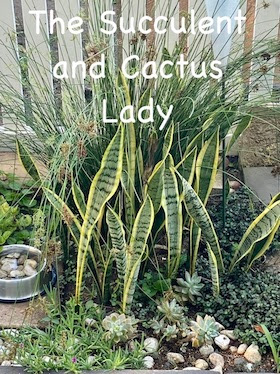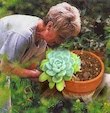My newly-acquired Gasteria glomerata on the left sharing a pot with Huernia longituba
I acquired my Gasteria in February this year (2015) by way of an on-line auction on FaceBook and after winterizing inside my house for two months, I was thrilled to discover a small! flower soon after I put it outside at the beginning of spring. I juts can't wait to see it fully open!
Gasteria glomerata is a stemless, compact succulent plant with an unspotted but slightly roughened grey-green leaf surface. Leaves grow in a single line (distichous), but the plant clumps up freely to make a mat. Already I see a baby peeping through on the left! It is native to the Eastern Cape of South Africa.
.
G. glomerata is a rare endemic confined to the lower Kouga River, now part of the Kouga Dam. Although it is rare, its status is not threatened at all due to its cliff face habitat and it is protected within a reserve. The seed is also dispersed world-wide and the plant is commonly grown in many collections. Its ease of propagation ensures that it is not necessary to collect plants from the wild.
The terrain of Gasteria glomerata is rugged, inhospitable and the plants occur on sheer, vertical, shady, south-facing rocky ledges (altitude 500-700 m), in minerally poor, slightly acid quartzitic sandstone soils. Gasteria glomerata is pollinated by sunbirds. Its fruiting capsule, opens from the top to release the flattish seeds. The fleshy leaves store water and are therefore drought tolerant, making this an ideal water-wise garden plant. Even though its habitat on the cliffs is very exposed, and is bone dry at times, the plants receive enough water from seepage for survival.
.
It is popular due to its horticultural value, and can be grown in small containers or in succulent plant gardens and is easily propagated from leaf cuttings or seed. It is a slow growing, but long-lived species. Leaf cuttings should first be allowed to dry and heal by placing them on a cool windowsill for at least three weeks. The basal part should preferably be treated with a fungicide. Plant the leaves in an erect position or lying on their side in sandy soil. Rooting is rapid and young plants can be harvested the following season.
.


















